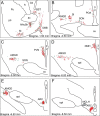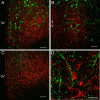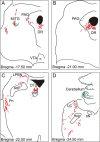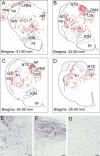Expression and distribution of glucagon-like peptide-1 receptor mRNA, protein and binding in the male nonhuman primate (Macaca mulatta) brain
- PMID: 25380238
- PMCID: PMC4272390
- DOI: 10.1210/en.2014-1675
Expression and distribution of glucagon-like peptide-1 receptor mRNA, protein and binding in the male nonhuman primate (Macaca mulatta) brain
Abstract
Glucagon-like peptide-1 (GLP-1) is released from endocrine L-cells lining the gut in response to food ingestion. However, GLP-1 is also produced in the nucleus of the solitary tract, where it acts as an anorectic neurotransmitter and key regulator of many autonomic and neuroendocrine functions. The expression and projections of GLP-1-producing neurons is highly conserved between rodent and primate brain, although a few key differences have been identified. The GLP-1 receptor (GLP-1R) has been mapped in the rodent brain, but no studies have described the distribution of GLP-1Rs in the nonhuman primate central nervous system. Here, we characterized the distribution of GLP-1R mRNA and protein in the adult macaque brain using in situ hybridization, radioligand receptor autoradiography, and immunohistochemistry with a primate specific GLP-1R antibody. Immunohistochemistry demonstrated that the GLP-1R is localized to cell bodies and fiber terminals in a very selective distribution throughout the brain. Consistent with the functional role of the GLP-1R system, we find the highest concentration of GLP-1R-immunoreactivity present in select hypothalamic and brainstem regions that regulate feeding, including the paraventricular and arcuate hypothalamic nuclei, as well as the area postrema, nucleus of the solitary tract, and dorsal motor nucleus of the vagus. Together, our data demonstrate that GLP-1R distribution is highly conserved between rodent and primate, although a few key species differences were identified, including the amygdala, where GLP-1R expression is much higher in primate than in rodent.
Figures







References
-
- Kreymann B, Williams G, Ghatei MA, Bloom SR. Glucagon-like peptide-1 7-36: a physiological incretin in man. Lancet. 1987;2(8571):1300–1304. - PubMed
-
- Edwards KL, Stapleton M, Weis J, Irons BK. An update in incretin-based therapy: a focus on glucagon-like peptide-1 receptor agonists. Diabetes Technol Ther. 2012;14(10):951–967. - PubMed
-
- Merchenthaler I, Lane M, Shughrue P. Distribution of pre-pro-glucagon and glucagon-like peptide-1 receptor messenger RNAs in the rat central nervous system. J Comp Neurol. 1999;403(2):261–280. - PubMed
Publication types
MeSH terms
Substances
Grants and funding
LinkOut - more resources
Full Text Sources
Other Literature Sources

